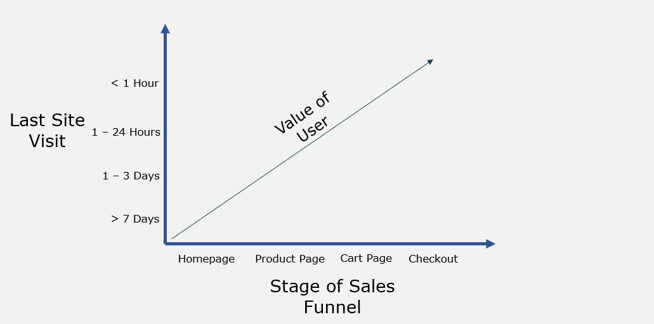Display retargeting has long been regarded as a must-have tactic for advertisers, as an effective method of re-igniting interest in prospects and customers.
But like with most paid media, a one-size-fits-all approach is generally going to result in wasted spend. With retargeting, even though you're reaching users who are aware of your brand, the same rule still applies. It’s crucial that as campaigns progress through learning phases, you begin to understand the audiences better, and identify the patterns and behaviors that are most likely to lead to conversion.
Like with a brand awareness campaign, everyone in your retargeting audience is different – and how they respond to your win-back tactics is all dependent on how you approach them as an individual. That approach should determine other campaign elements like ad copy, creative design, and bidding strategy.
If you're unfamiliar with display retargeting, check out our previous article, Getting Started with Retargeting Ads for a quick refresher.
If you're not getting the return you'd hoped for with retargeting, then this article is for you! We’ll discuss five different optimizations you can make to your campaigns using a cost-effective audience refinement strategy.
Impression Frequency and Retargeting Windows
How long should a prospective customer be retargeted for? How frequent should impressions be served to this individual? When making these decisions, consider the following:
- The products or services being sold
- The customer’s website activity, or stage in the sales funnel
- The last time a conversion event or page view occurred
A website visitor who merely visits a homepage should be served ads much less frequently, and for a shorter period of time, than someone who adds products to their cart, for example.
Additionally, industries that tend to have longer buying cycles, like finance or automotive, should serve retargeting ads to users for a longer duration than a business that sells lower-priced items like groceries or novelty items. Maintaining a high-quality retargeting audience by filling it with the most recent, in-market users will lower your cost-per-acquisition and ensure that each impression served is making the most impact.
Lastly, serving ads based on last visit or event. As time passes from the last interaction, the lower the probability of converting the user. How frequent and for how long you serve impressions to a user should be dependent on their probability of converting. It’s therefore fairly intuitive to serve ads less frequently to someone whose last visit was weeks instead of hours ago.

Bidding Adjustments
Like with impression frequency, the value of an audience segment should also determine the bids you set for each impression.
High value segments (i.e., checkout page visitors): For these segments, winning the auction and ensuring that impressions are served to the right user is the goal. So the right move here is to increase your bids. As you increase bids you end up winning more auctions, but your overall reach will decrease as a result.
Lower value segments (i.e., homepage visitors): For these segments you want to reach as many users as possible. They may have lower intent than other visitors, so it’s more of a guessing game as to determining who is likely to become a customer. For this reason you want to decrease your bids so you reach as many of these users as your budget allows. The goal for these segments is quantity over quality and to maximize exposure.
Audience Exclusions
Depending on audience size, you may want to narrow down your audience to more high-quality users. Serving an ad to someone who’s no longer interested or not a good fit for your products is a waste, when that budget could’ve been allocated to more high-value customers. To get the greatest return on your ad spend, add audience exclusion segments to your campaigns.
For example:
Exclusions based on geolocation: Exclude audiences that reside in states or countries you don't ship to.
Exclusions based on non-transactional website activity: For retail sites especially, avoid wasting ad spend on folks who are on your site for perhaps non-transactional means. Create an exclusion audience of users who visit your site purely for educational or career-related purposes.
Audience Expansions
By contrast, think of some creative ways you can expand retargeting audience. The larger your retargeting audience size, the more likely you’ll exhaust budget, and the more flexible you can be with segmentation. You’ll also be able to quickly understand what’s working, what isn’t, and make the necessary optimizations.
Not all retargeted users need to have just visited your site.
So if you’re experiencing low volume website traffic and it’s preventing your retargeting campaigns from performing up to speed, a great way to increase the size of the audience is by adding a retargeting pixel to your brand newsletters, abandonment emails, or other similar communication. This is an effective way of reaching customers in your CRM who haven’t engaged with your brand for an extended period of time, to reignite old relationships and cultivate loyalty.
Dynamic Creative
The key to optimal retargeting ROAS is being personalized. After all, applying customized messaging to your ads creates relevancy and reminds users of their interests. It’s a major reason why retargeting is so effective.
Serving ads programmatically gives you the option of adjusting creatives at the time the impression is served, within microseconds. As long as multiple creatives are built within the ad serving platform, and the trigger rules are properly set, advertisers can customize creatives based off of a number of factors, including:
- Time
- Weather
- Location
- Product interest / behavior
- Demographics
Not only does dynamic creative allow for memorable brand experiences at scale, it can improve overall campaign performance by being able to test out multiple different versions of an ad, helping advertisers understand what type of messaging and imagery is going to have the most impact.
Conclusion
As you refine your audience and divide it into more specific segments, the goal still remains clear: achieving the best possible return on ad spend. So while granularity and individualization is a critical piece towards optimal ROAS, don’t let it prevent you from reaching any low hanging fruit. The key is balancing individualization with volume and scale.
For inquiries into pricing and to request a customized media plan, reach out to one of our experts today! For a more detailed look into how Cybba's retargeting programs work, download the Display Retargeting Datasheet:



